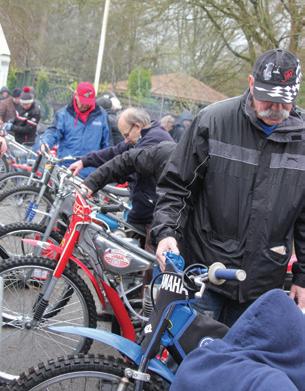
3 minute read
What Goes Around
By Alan Turner
Speedway Anniversary, Speedway Museum, Broxbourne, Herts - 23rd February, 2020
Advertisement
It may be hard to imagine that at one time speedway was the second biggest spectator sport in the country. However, dig long enough among the crammed-to-the-rafters artefacts in the Speedway Museum at Paradise Park, located in its own building in the Hertfordshire zoo owned by former rider Pete Sampson, and you'll find plenty of evidence. If not, try any of the purveyors of memorabilia plying their wares in the marquee that's used for the annual Anniversary event. Magazines and programmes record that most towns had a stab at offering speedway as entertainment, with peaks of interest in the decades either side of WWII.

Classic Hagon-JAP, behind, the ESO that soon evolved into Jawa and ended the British manufacturers decades of dominance
But there's very much a live element to the day. A few modern teams keen to reveal their fixture lists, then enthusiasts and collectors with displays of bikes, many with interesting history. Andy Day had discovered a ComerfordJAP, a bike that came from speedway's earliest days, when
Comerfords (one-time major dealers at Thames Ditton, Surrey) were among the first to produce specialist speedway frames, but the engine predated the dedicated JAP Speedway engine and the bike had a Sports 350 unit. With restoration completed, Andy's hoping to give it some laps at the Isle of Wight speedway this summer.

The Vintage Motor Cycle Club (Grass Track and Speedway Section) attracted plenty of interest at Paradise Park
Elsewhere, there were a few examples of the Rotrax-JAP. For some, these are the peak, not just of speedway bikes, but of any competition machinery. When they were launched, the construction method was really cutting-edge. Finished in chrome plate and bright alloy they are utterly functional and punching out around 45bhp in a bike that weighed 77kg (170 pounds) acceleration was on the shoulder-wrenching side of rapid. One collector had a Polish copy, badged FIS, built when the Cold War made it almost impossible for British bikes to be sold in Eastern Europe. From later eras, Weslakes, Jawas, Hagons were all there to be admired.
Every hour, on the hour, a fire-up paddock brought a crowd to hear 500cc singles on open pipes distribute the heady mix of 'dope' (methanol fuel) and castor oil. Former riders wander the crowd, readily signing autographs, and posing for photos. They meet former team-mates and opponents and reminisce over former races and rivalries.

Egon Müller rarely looked this sombre. He wears the World Speedway Riders' Association chain of office
As well as the Hagon family, it was great to see Sam Norris. A very talented young rider, a big accident at Glasgow left him in a very poor state of health. Not only has he recovered, but is keen to ride again! He has been helping his father restore some Weslake track bikes and he wants to find out what they were all about.

An hourly spectacle – a line of bikes fired into life and warmed up drew a crowd every time
The occasion is also the transfer of the chain of office of the President of the World Speedway Riders' Association. The honour has been passed to many of speedway's leading lights. Last year, it was Mike Broadbank, who had enjoyed a long career with Swindon, but his final duty was to hand over the chain to the new incumbent – Egon Müller.

Former racer Frank Wendon restored this Jawa, as raced by Alan Cowland, an Exeter rider in the sixties before moving to various other clubs
Egon's track career spanned the seventies and eighties. While his speedway results were uneven, he scored a maximum in 1983 to become the only German (so far) to win the World title, contested as a single event at the time. His real strength was in long-track racing, where he achieved numerous honours, especially using engines prepared by Hans Zierk, a former long-track ace. His appearances at UK grasstrack were rare, but when he did, rivals generally saw his rear wheel vanishing into the distance. In parallel with track racing, he was also a singer and show business personality. His acceptance speech of his latest honour was delivered in perfect English and he seemed to be genuinely touched by the recognition. He may have retired from track racing almost three decades ago, but there was no shortage of fans queueing for his autograph.

Andy Day's Comerford-JAP – low bars, a right-side knee brace, this bike was for the leg-trailing style of riding that marked speedway's early efforts
By mid-afternoon, it was all over for another year. The traditional February date may be at odds with the modern speedway season, but actually marks the closest to what is recognised as the date of the inaugural speedway meeting, held at High Beech in 1928 and successful beyond the promoter's wildest dreams. By its nature, speedway is under even greater pressures than other motorcycle disciplines in fighting to survive.
We can only hope it continues to add to the great memories evoked at Paradise Park .







